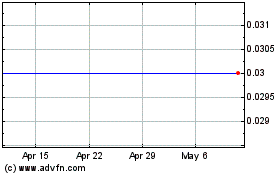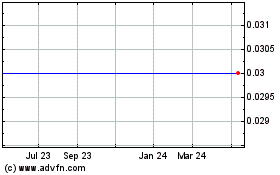Pancontinental Uranium Corporation (TSX VENTURE: PUC) ("Pancon")
and joint venture partner Crossland Uranium Mines Ltd. (ASX: CUX)
("Crossland") are pleased to advise that assays have been received
for the first seven holes of a 15-hole core drilling program to
investigate the uranium potential of the Cockroach Dam Prospect at
the Charley Creek Project, southern Northern Territory.
The joint venture's Charley Creek Project is located in the
Teapot Granite complex, an unusual geological unit well known for
its high radioactivity, and which is prospective for the discovery
of commercial uranium deposits.
Crossland's Exploration Director, Geoff Eupene, said "the
initial investigations, focussing on the Cockroach East and
Cockroach Central zones of the prospect, have provided encouraging
results and the crucial information required to target the large
tonnage uranium deposits the joint venture is looking for in and
around the Teapot Granite."
"The remainder of the drill program for 2010 will be directed at
these areas and how best to evaluate them with further drilling in
2011," Mr. Eupene said.
Highlights
-- A best intersection from the initial seven (7) holes of core drilling at
the Cockroach Dam prospect of 2m of 876ppm U3O8 from 148m, including
0.3m of 4,079 ppm U3O8 from 148.8m.
-- Thick intersections of granite with uranium contents up to 10 times the
global average content for granite (up to 40ppmU) indicate that these
zones within the Teapot Granite are fertile source rocks for a variety
of uranium deposit styles, including in particular Rossing (Namibia)-
style granite-hosted bulk low-grade mineralization.
-- The results suggest that the best chances for significant grades and
widths of economic mineralization are in areas where the granites are
strongly fractured, and probably not outcropping. The remainder of the
2010 drill program will be directed at these areas with further drilling
in 2011.
-- The drill program for uranium will run in parallel with the Charley
Creek REE evaluation program, also targeting the Teapot Granite as well
as its surrounding host rocks and alluvium for REE.
Background
The Charley Creek Project is one of three projects in the NT and
one in South Australia which are subject to a 50:50 joint venture
between Pancon and Crossland, initiated in 2007, to explore for
uranium in Australia and elsewhere.
The Cockroach Dam Prospect covers approximately 120 square
kilometres of the highly radioactive Teapot Granite. The total area
of Teapot Granite within the joint venture's tenements exceeds 230
square kilometres, which represents the majority of this unusual
granite that is available for exploration. Previous surface rock
chip sampling by Crossland at Cockroach Dam returned an average
uranium content for all 186 samples of 439ppm U3O8.
While these widespread surface values provide encouragement, it
is necessary to drill to determine if these are the result of
surface enrichment, and to assess continuity of grade with depth.
Crossland gained clearance to commence a more intensive exploration
program, including drilling, at Cockroach Dam in late July, 2010,
and immediately embarked upon a core drilling program of at least
1,500m in ten (10) holes. This program has been expanded as it
progressed, and the Stage 1 drill program at Cockroach Dam is now
expected to total 15 holes to around 150m average length. This
program is expected to be completed before the Christmas break.
There have been delays to both drilling and core processing as a
result of unusually high rainfall throughout 2010.
Results
Laboratory results have just been received for the first seven
(7) holes of this program, a total of 728 samples, including five
(5) holes from Cockroach East, and the first two (2) of ten (10)
holes planned at Cockroach Central. This release is intended to
provide an initial synthesis of the results. All uranium results
quoted have been reported on samples that are sections of sawn half
core (size HQ or NQ2), normally of 1m length, unless high-grade
mineralization was encountered. Half core samples have been
submitted for preparation and analysis by ALS Laboratory Group,
using its method ME-XRF05. Intervals for assay have been selected
based on down hole total count radiometric probe results.
Uranium values ranged from less than the detection limit of
4ppmU, (6 samples associated with basic dykes and associated
mylonitic schists) to a highest value of 3,470ppmU (4,079 ppmU3O8),
from 148.8- 149.1m (interval 0.3m) in hole CED2010_006. The best
uranium intersection, using a cutoff of 250ppmU, was from 148m to
150m (2m) at a grade of 743ppmU (876ppmU3O8), in hole CED2010_006,
incorporating the higher-grade intersection mentioned above.
Table : Intersections of greater than 1m of greater than 250ppmU
in holes CED2010_001 to CED2010_007
------------------------------------------------
From To Int
Hole (m) (m) (m) ppmU3O8
------------------------------------------------
CED2010_006 148 150 2 876
------------------------------------------------
including 148.8 149.1 0.3m 4,079
------------------------------------------------
Some 567 samples (78%) exceed 20ppmU, while 293 (40%) exceed
32ppmU, 89 exceed 40ppmU, and 13 exceed 50ppmU over 1m intervals.
Values exceeding 50ppmU are associated with peaks in the
radiometric logs that indicate uranium mineralization processes
(oxidation or hydrothermal alteration) have mobilized uranium;
values less than 50ppmU but above 20ppm seem to be frequent in some
broad zones within the granite, suggesting these are background
values for those phases. Of the 13 values exceeding 50ppmU, all but
one are from holes CED2010_006 and CED2010_007 at Cockroach
Central.
Preliminary Interpretation
There are several important generalizations that can be
concluded from the assay data, the down hole radiometric results,
and our evolving geological observations:
-- Every hole demonstrates an overall depletion in uranium content between
the surface and the depth of oxidation (the oxide zone). This means that
a considerable proportion of uranium is readily dissolved from the
granites where they are exposed to surface oxidation. The many patches
of secondary uranium mineralization observed on granite surfaces is the
result of the ready mobilization of the primary uranium minerals
dissolved from the oxide zone.
-- There are widespread granite zones with high primary uranium content at
the Cockroach Dam Prospect. For example, the first 50m of Hole
CED2010_001 below the 4m thick oxidized zone averages 40ppmU, which is
10 times the average uranium content for all granites globally. The
Teapot Granite is a very fertile source for uranium deposits, which can
readily be dissolved in surface waters as observed above. This dissolved
uranium is available to deposit in sites of secondary precipitation from
surface waters, such as:
-- Local re-precipitation of oxidized uranium minerals such as uranophane
Ca(UO2)2(SiO3OH)2.5H2O, as is already observed at Cockroach Dam. A
variety of uranophane is an important source of uranium at the famous
Rossing Mine in Namibia. Cockroach Dam appears to have other
geological similarities with deposits in the Rossing district.
-- Deposition in calcrete deposits in surface-related drainages, as
carnotite
-- Deposition in deeper sediment basins such as those present beneath the
Charley Creek flats, and the Ngalia (Bigyrli) and Amadeus Basins
(Angela/ Pamela deposits) elsewhere in the region, at
oxidation/reduction interfaces, as pitchblende and coffinite.
-- Preliminary geological logging of the core indicates that uranium
contents increase around zones of fracturing, where secondary minerals
are sometimes observed associated with rock oxidation; within and close
to zones of basic dyke intrusion and shearing, which are frequently
observed in mylonite zones; around other veins and alteration zones in
the granite; and in contact zones where the granite bodies interfinger
with sediments. In some of these styles of concentration, uranium occurs
as primary unoxidized mineralization as in the higher-grade zone
reported above.
It is important to emphasize that while uranium may be more
obvious at surface on the prominent granite hills through the area,
it follows from the observations above that the best chances for
significant grades and widths of economic mineralisation are in
areas where the granites are less well preserved at surface, in
zones of shearing and deeper weathering that often occur along the
margins of the granite bodies. The remainder of the drill program
for 2010 will be directed at these areas and how best to evaluate
them with further drilling in 2011.
This uranium exploration activity will be conducted in parallel
with the joint venture's evaluation of Rare Earth alluvial heavy
mineral deposits as advised to the market on November 22, 2010.
All technical information in this release has been reviewed by
Geoff Eupene, Qualified Person for Crossland and Pancon.
About Pancontinental Uranium Corporation
Pancontinental Uranium Corporation ("Pancon") is a
Canadian-based company focused on uranium discovery and
development. Through a 50:50 joint venture with Crossland Uranium
Mines Limited ("Crossland") of Australia. Pancon has established
one of the strongest management teams in the uranium industry. This
management and operating team has unparalleled experience from
exploration, through development to operations, and includes people
who were instrumental in the discovery of two of the largest
uranium deposits in the world. Pancon and Crossland hold an
impressive uranium exploration portfolio with projects in prolific,
mining friendly districts.
Active exploration is ongoing at three Australian projects which
include Chilling, Charley Creek, and Kalabity. The Chilling project
has the potential to host a mirror image of a portion of the
renowned Alligator Rivers Uranium Field containing the large
Jabiluka, Ranger and Koongarra deposits. Charley Creek has the
potential for large, lower-grade, Rossing-type, granite-hosted
uranium deposits and REE. The Kalabity project lies in a district
of historic uranium/radium mining that contains a variety of known
uranium deposit styles.
Pancon has earned a 50% interest in this significant uranium and
REE project portfolio through the joint venture with Crossland
through the expenditure of A$8 million. Pancon and Crossland are
also pursuing exploration beyond Australia through an international
subsidiary company, Crosscontinental Uranium Limited, and immediate
plans include formulating an exploration program in Burkina
Faso.
ON BEHALF OF THE BOARD OF DIRECTORS
Rick Mark, President & CEO
For additional information, please visit our website at
www.PanconU.com.
Neither TSX Venture Exchange nor its Regulation Services
Provider (as that term is defined in the policies of the TSX
Venture Exchange) accepts responsibility for the adequacy or
accuracy of this release.
Contacts: Pancontinental Uranium Corporation Richard Mark
President and CEO 604-986-2020 or 1-866-816-0118 Pancontinental
Uranium Corporation Keith Patey Director of Communications
604-986-2020 or 1-866-816-0118 604-986-2021 (FAX)
www.PanconU.com
Pancontinental Resources (TSXV:PUC)
Historical Stock Chart
From Feb 2025 to Mar 2025

Pancontinental Resources (TSXV:PUC)
Historical Stock Chart
From Mar 2024 to Mar 2025
